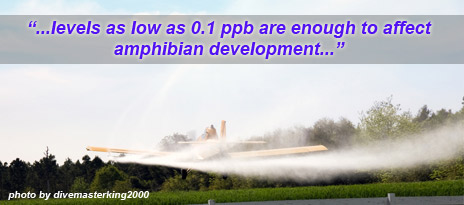
The widespread use of thousands of pesticides, which broadly includes insecticides, herbicides and fungicides, that were once considered safe for wildlife have recently become the subject of many studies. Results from these studies conclude that there is strong evidence linking the application of pesticides and amphibian population declines. The most commonly used pesticide, atrazine, has been shown in both laboratory and field observations to cause hermaphroditism, developmental and behavioral malformations, and the disruption of normal endocrine system functions (Hayes 2002; Storrs 2004). Atrazine levels as low as 0.1 ppb are enough to affect amphibian development and are in contrast to previously held beliefs that high concentrations were required to induce abnormal growth (Hayes 2002).
Instead of very high doses not seen frequently in natural habitats, these studies have shown that ecologically relevant doses observed in watersheds are a concern for amphibians. The overlapping of the amphibian life cycle and agriculture practices has put them at risk to pesticide contamination. Besides possessing thin permeable skin susceptible to chemicals, and spending their lives in and around water, amphibians are in the breeding season when atrazine is typically applied in the spring. This is also a period in which rainfall levels are generally high, runoff is abundant, and amphibians are in the early stages of development. In the United States, the allowable contaminant level of atrazine in drinking water is 3 ppb and short exposures to 200 ppb are not deemed a health risk (Hayes 2002). However, results have indicated that it is not uncommon for atrazine concentrations to be 7x to 75x more than the allowable level in ground and surface waters throughout the U.S. In some Midwestern agricultural regions, contaminating levels have reached as high as 760x this allowable level (Hayes 2002). Thus, the chances of amphibian populations being exposed to at least 0.1 ppb of atrazine, a concentration found to adversely affect amphibian development, are very high.
Independent observations by Storrs and Hayes have both shown that atrazine in lower concentrations can have a greater impact than exposure to higher concentrations. Besides mortality, atrazine has similar properties of endocrine disruptors, which explain the incidents of hermaphroditism, developmental malformations, reproductive abnormalities and growth retardation in both early and late stage amphibians. Depending on the developmental stage, exposure to pesticides and endocrine disruptors are adversely affecting populations and indicate the need to modify current toxicological detection standards to include low level testing procedures.
In addition to modifying traditional thinking and implementing low-level chemical testing to identify possible contamination after the fact, it is essential for continued studies involving the mechanisms by which contaminants are transported after application. Results by Konda (2001) confirmed that the transportation of pesticides by runoff and downward movement through soil layers coincides with precipitation. Stream contamination, pesticide concentration in surface runoff, and presence of pesticides in multiple soil layers increases dramatically the closer rainfall events occur to the time of application. Results from plots with recently applied atrazine and other pesticides had the highest concentrations in runoff when rainfall occurred shortly after this application period, and generally within the first 100 days. Konda explains that the initial leaching of pesticides and runoff concentrations are high, although dependent upon volume and intensity of rainfall, because runoff and erosion are increased by the lack of vegetation that protects the soil later in the crop season. As expected, these high concentrations of pesticides in runoff cause significant stream contamination, and typically produce concentrations higher than U.S standards for atrazine in drinking water.
An understanding of the transportation and retention of pesticides in soil is necessary for the development of protocols to prevent the continued contamination of surface water and groundwater. Although more studies need to be and will be done concerning the mechanisms and movement of pesticides after application, it is clear from these studies that once considered ecologically safe levels of pesticides in both soils and waters are of great concern to the overall health of the environment and testing must be conducted with realistic exposures. Although population declines cannot be solely attributed to the ever increasing presence of pesticides, it is a definite factor that may be working in conjunction with other environmental stressors to affect amphibians world-wide.


[…] JournOwl- Wildlife news, Wildlife conservation » Atrazine: Here an … […]
[…] By the way, check out my post on atrazine…Atrazine: Here an herbicide there an herbicide […]